Since I was a young child Mars held a special fascination for me. It was so close and yet so faraway. I have never doubted that it once had advanced life and still has remnants of that life now. I am a dedicated member of the Mars Society,Norcal Mars Society National Space Society, Planetary Society, And the SETI Institute. I am a supporter of Explore Mars, Inc. I'm a great admirer of Elon Musk and SpaceX. I have a strong feeling that Space X will send a human to Mars first.
Tuesday, October 31, 2023
My Suborbital Life, part 4, My Research Spaceflight Training Countdown To Launch
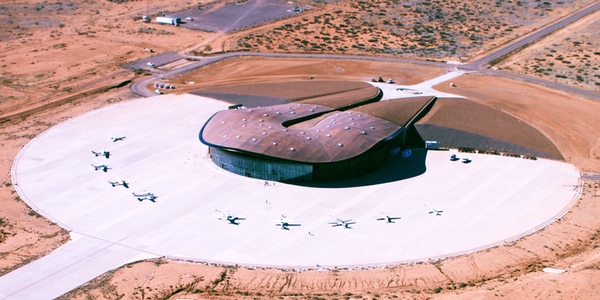 The central hub of Spaceport America in New Mexico. (credit: Spaceport America) |
My suborbital life, part 4: My research spaceflight training countdown to launch
by Alan Stern
Saturday, October 28, 2023
It’s just T-5 days to launch on my first space mission, which is set for liftoff on Thursday, November 2, from Spaceport America in southern New Mexico. Spaceport America is Virgin Galactic’s operations base for commercial suborbital missions.
My essay today is about training for this mission. Unlike space tourists, those of us going to do research in space are there to work, and that means a whole different level of training than is needed just to ride aboard the vehicle as it goes through its flight paces. Most of that additional training is to ensure we’ll be ready to get our work done in the compressed timeline of just minutes during the actual spaceflight-altitude portions of the mission.
| Unlike space tourists, those of us going to do research in space are there to work, and that means a whole different level of training. |
Toward that end, I’ve been in almost daily procedures run-throughs for my research flight for several weeks. Additionally, to support being physically ready to perform at a high level after launch and in microgravity during the spaceflight, I undertook a refresher high-G training course last month on the NASTAR centrifuge in Pennsylvania. That involved six high-G runs up to 5.5 Gs, significantly exceeding the Virgin Galactic suborbital launch and entry profiles. I also did a series of Zero-G Corporation training flights over the past couple of years.
On Saturday, October 28, my training will enter its last phase when I arrive in New Mexico to begin on-site training at the launch site. The main task after arrival on Saturday will be our flight suit fitting.
Then Sunday, October 29, is “L-4”, or launch minus four days. The focus of that day will be final payload preparations and a first tour and practice of the flight operations inside Virgin Galactic’s precise, high-fidelity spaceship Unity trainer.
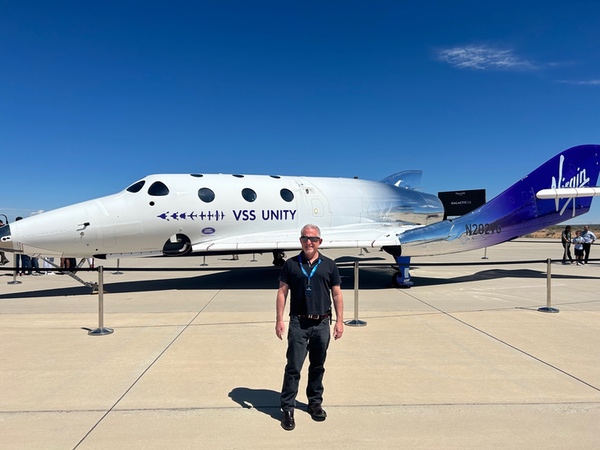 Myself in August in front of SpaceSpaceTwo after it landed at Spaceport America following the Galactic 02 flight. (credit: Alan Stern) |
The pace picks up on Monday, at L-3 days. That day is focused on suit training, seat training, and high G classroom lessons for launch and entry.
On L-2 day, my crewmates and I will undergo G-awareness training in aerobatic aircraft flights, and further mission simulations with our research gear in the high-fidelity Unity cabin trainer. Then we’ll train on emergency equipment, and we’ll have some availability to interact with media who are attending the launch.
On Wednesday, November 1, which is L-1 day, we’ll do another mission sim in the Unity cabin trainer, have a master class with previous flyers on Unity, and conduct a full launch day dress rehearsal and a launch readiness review. Then we’ll have some time off before showtime (our spaceflight!) the next day.
I’ll be blogging more details over the next week, but what’s above is the general plan, and I want you to have that inside view of what we’ll be doing as launch training goes into high gear and then culminates with the flight.
For now, I’m continuing with procedures training runs and really raring to go. As Virgin Galactic’s founding chief spacecraft designer, aerospace legend Burt Rutan, likes to say, I’m “looking up, WAY up!”
Alan Stern is a planetary scientist and aerospace executive. He is a former NASA Associate Administrator for Science, and a former board chair of the Commercial Spaceflight Federation. He has now been a part of 30 NASA, ESA, and commercial spaceflight flight mission teams, 15 of those as mission or instrument Principal Investigator, including the almost $1 billion New Horizons mission to Pluto and the Kuiper Belt.
My Suborital Life, part 3, The Suborbital Revolution Is Here
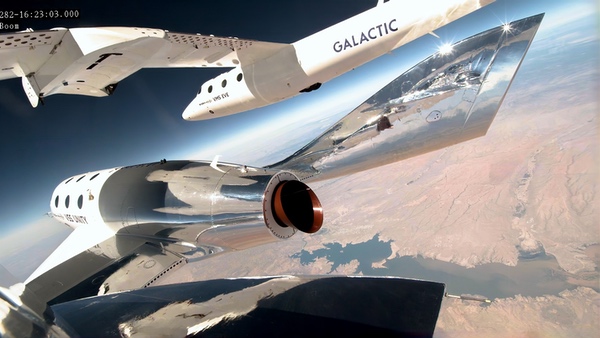 A Virgin Galactic suborbital spaceship at release from its carrier aircraft for ascent to space. (credit: Virgin Galactic) |
My suborbital life, part 3: The suborbital revolution is here
by Alan Stern
Friday, October 27, 2023
As I write this blog, I’m about to leave on a business trip to Boston, to lead a science team meeting of the NASA New Horizons mission, which I serve as Principal Investigator (PI) for. The meeting is a typical business trip, one of over a thousand that I’ve made in my career.
My next business trip is, as usual, replete with admin assistance, travel reimbursement rules, and a post-trip expense report to file. But despite all that, it isn’t a routine trip at all.
| To me, having spent my entire career to date in the service of space exploration, space development, and the space sciences, going to space to actually work there is a badge of honor. |
I’ll be headed to southern New Mexico for that one, to launch into space on a suborbital research and training mission aboard Virgin Galactic. Without a doubt, it’s going to be the most memorable business trip I’ve ever taken, even topping my unforgettable 1995 astronaut interviews in Houston, and the 2006 launch and 2015 Pluto flyby trips for New Horizons.
Most people who travel to space today are suborbital space tourists. Not here. Instead, I’ll be traveling on behalf of my employer, the Southwest Research Institute (SwRI), as a working researcher, performing specific tasks with specific objectives on the spaceflight.
To me, having spent my entire career to date in the service of space exploration, space development, and the space sciences, going to space to actually work there is a badge of honor, and a very rare one. But I don’t expect that will be the case very much longer.
Why? Because the commercial space revolution is lowering costs and widening access to space in many ways. One of the most important in my view, is the way commercial space is revolutionizing the nature of suborbital research.
What is suborbital research? It’s the use of rocket- and balloon-powered vehicles to study the Earth and space from altitudes far above those achieved with aircraft. Suborbital research got its first real foothold in high altitude ballooning and post-World War II “unmanned” rocketry in the 1950s. These systems proliferated in the 1960s through the 1980s, when I first became involved. My role initially was as an engineer on University of Colorado sounding rockets to study the upper atmosphere and making astronomical observations using ultraviolet spectrometers. Later, as I became a scientist, was on the science team of several other suborbital sounding rockets, and then after earning my PhD, I led seven such suborbital missions as PI. Except for one rocket launched from Poker Flat, Alaska, all of the rocket missions I’ve been involved in flew from White Sands Missile Range (WSMR) in southern New Mexico.
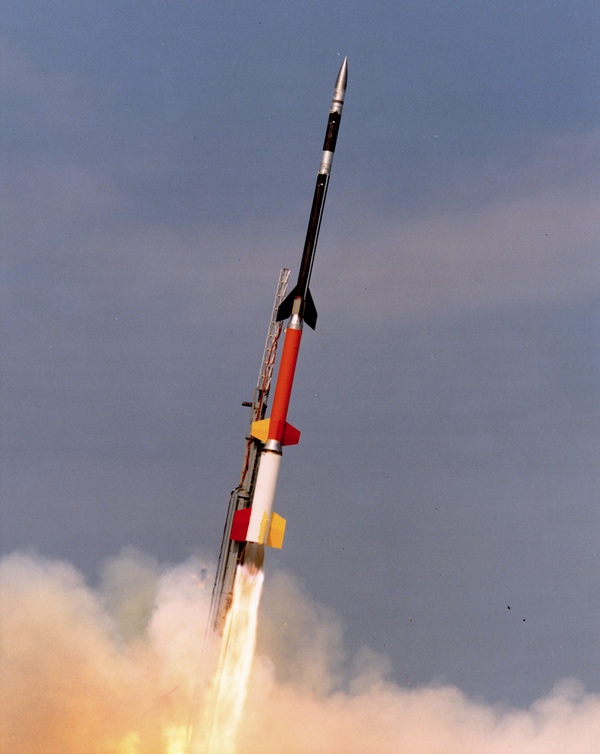 A traditional uncrewed suborbital rocket experiment launches from WSMR. (credit: NASA) |
When I was involved in that kind of work, which stretched into the early 2000s, I don’t think I ever imagined that one day I’d launch to space suborbitally from southern New Mexico, and barely around the corner from White Sands on maps of the United States.
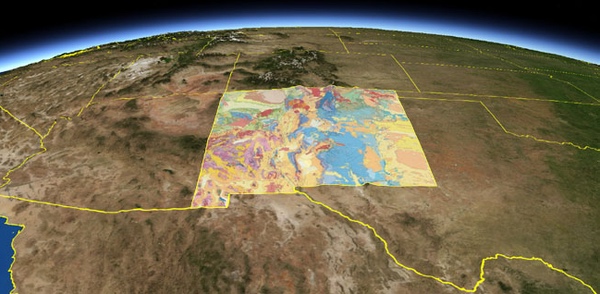 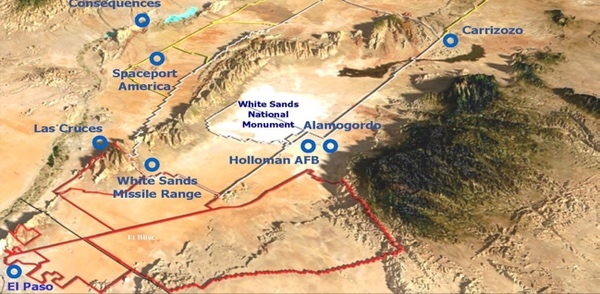 New Mexico and its two spaceports, White Sands Missile Range and Spaceport America. |
But on November 2nd, or soon thereafter, I’ll be doing exactly that, ascending to an altitude of nearly 90 kilometers for a brief but intense space mission—just like the 14 suborbital sounding rocket missions I was involved in as an engineer, a science team member, and later as PI.
What is game-changing with new generation suborbital rocket systems like those that Virgin Galactic and Blue Origin fly, and with the soon to be flying high-altitude ballooning systems World View and Space Perspective are designing, is twofold.
First, these new vehicles will allow research flights 10 to 100 time as often, and at 5 to 10 times, and in some cases even 100 times, lower in cost than the older, legacy rockets and balloons. And in just the same way that the PC revolution took computing from rare to routine, and from outrageously expensive to a common commodity, the new generation suborbital systems are opening up whole new ways of doing suborbital space research that could have never before happened.
| In just the same way that the PC revolution took computing from rare to routine, and from outrageously expensive to a common commodity, the new generation suborbital systems are opening up whole new ways of doing suborbital space research that could have never before happened. |
As a result, fields as diverse as space physiology, microgravity research, astrophysics, Earth observation, and education/public outreach are all going to see a proliferation of new applications, expanded access, and the normalization of suborbital research to something more akin to the use of airborne research platforms.
Equally powerfully, if not even more so, is the second great advance these new vehicles offer by carrying experimenters and educators to space. Putting these people in space to do their work means eliminating the costs, risks, and numerous failure modes of automated experiments that the legacy rocket and balloon systems of the 20th century demanded.
Flying experimenters and educators is also going to dramatically amplify real time experiment innovation in the same way that scientists and educators doing their work on site in volcanology, oceanography, at astronomical observatories, and in laboratories everywhere have always been able to, but which space experimenters and educators simply could not do—until now.
I’m excited to be at the vanguard of this space research revolution, and look forward to flying and doing research in space many times after my upcoming first flight. It might be over the top, but it’s not impossible that our SwRI team toast about who among us will fly to space the most (“First to fifty!”) might just come true before too very long.
Alan Stern is a planetary scientist and aerospace executive. He is a former NASA Associate Administrator for Science, and a former board chair of the Commercial Spaceflight Federation. He has now been a part of 30 NASA, ESA, and commercial spaceflight flight mission teams, 15 of those as mission or instrument Principal Investigator, including the almost $1 billion New Horizons mission to Pluto and the Kuiper Belt.
Book Review-Deep Sky
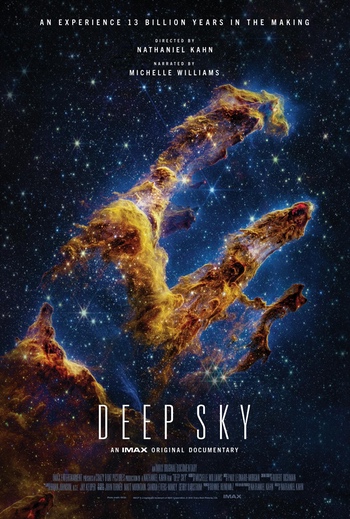 |
Review: Deep Sky
by Jeff Foust
Monday, October 30, 2023
Deep Sky
directed by Nathaniel Kahn
IMAX, 2023
40 minutes, unrated
It was inevitable, perhaps, that a very big space telescope would end up on a very big screen. Once it was clear that the James Webb Space Telescope was both a technical and scientific success, putting its dramatic images on an IMAX screen was something close to a no-brainer. “It has to be on an IMAX screen because only that giant screen is making you fully immersed in these worlds,” said Nathaniel Kahn at a National Academies event in July.
He would know since is the director of that IMAX movie about JWST, Deep Sky. The documentary, the latest in a four-decade-old line of such films produced in cooperation with NASA, offers a condensed history of the development, launch, and commissioning of the telescope, but really shines when it’s time to show off the images that telescope can produce.
| There is a much greater emphasis on what JWST has produced, including both the first science images as well as subsequent observations. |
Deep Sky is not the first documentary about JWST: Netflix released one, Unknown: Cosmic Time Machine, this summer (see “Review: Unknown: Cosmic Time Machine”, The Space Review, July 31, 2023). The Netflix document spent much of its one-hour running time focusing on the challenges building the telescope, including its major cost and schedule overruns, and going behind the scenes during the launch and commissioning of JWST. The payoff—those first science images—comes towards the end.
Deep Sky shifts that balance towards the science. The difficulties developing JWST are mentioned but not in great detail in narration provided by actress Michelle Williams, instead moving ahead briskly to the launch—another spectacle well-suited to the IMAX screen—as well as commissioning. There is a much greater emphasis on what JWST has produced, including both the first science images as well as subsequent observations. Astronomers included in the film explain, with the help of both JWST images and computer graphics, how JWST observations can address key topics from the early universe to looking for potentially habitable exoplanets.
That difference is not unexpected. Talking heads and behind-the-scenes visits to NASA Headquarters work well for a documentary that might be watched on a home TV or even a tablet or phone, but people paying a premium to watch a relatively short film on an IMAX screen want to be dazzled. In that respect, Deep Sky does not disappoint. Even if the medium is not the message, it at least helps craft it.
One challenge with a film like Deep Sky is that it runs the risk of being outdated relatively quickly as more images and more science results come in from JWST. At a screening earlier this month at the National Air and Space Museum’s Udvar-Hazy Center, film executives said they worked to add new images up to the deadline, getting the last one—which features a galaxy merger that looks like a question mark—a few days before the film was completed. But being outdated in that manner is not a bad problem to have.
Jeff Foust (jeff@thespacereview.com) is the editor and publisher of The Space Review, and a senior staff writer with SpaceNews. He also operates the Spacetoday.net web site. Views and opinions expressed in this article are those of the author alone.
Note: we are using a new commenting system, which may require you to create a new account.
Shaking Up The Commercial Space Station Business
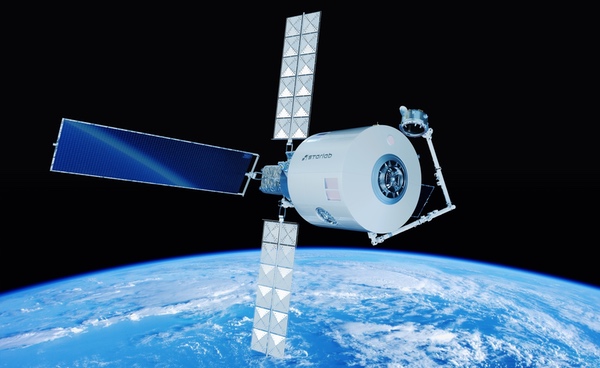 Northrop Grumman is joining forces with Voyager Space on the Starlab space station (above), dropping plans to develop its own. (credit: Voyager Space) |
Shaking up the commercial space station industry
by Jeff Foust
Monday, October 30, 2023
The early years of a new industry can be a bit chaotic. A wave of new entrants rush in, far more than can be reasonably supported by demand. The companies compete vigorously for customers and investment, while also forming—and breaking up—partnerships with one another. Ultimately, only a few will survive, with the rest subsumed by the winners or disappearing entirely.
That process is playing out in the commercial space station market. While companies are still years away from launching their first stations, hoping to attract NASA and other government and commercial customers, there is a lot of activity as companies join forces or potentially consider going their separate ways.
| “Although we’ve made a significant amount of progress and understood the business case,” Northrop’s Krein said, “there was just a stronger case to be made for a combination of the talents, expertise, and subject matter experts with ourselves, Voyager, and their partners.” |
On October 4, Northrop Grumman, one of three companies that received NASA awards through the Commercial LEO Destinations, or CLD, program in late 2021 to support design work on commercial stations, announced it was abandoning plans to develop its own station. Instead, it was teaming with Voyager Space, another company with a NASA CLD award, on that company’s Starlab station.
Under the partnership, Northrop said the companies would work together to develop a version of the Cygnus cargo spacecraft that could autonomously dock with Starlab; Cygnus spacecraft on missions to the International Space Station today have to be grappled and berthed by the station’s robotic arm. The companies said they would “further explore opportunities” for additional support for Starlab.
Northrop entered the CLD program as by far the largest and most experienced space company pursuing a commercial space station. It had expertise from Cygnus and other projects, like the HALO module it is building for NASA’s lunar Gateway, and had substantial corporate resources it could have devoted to a commercial space station: the company reported last week net earnings of $937 million in just the last quarter.
However, there had been speculation that Northrop, despite its technical and financial resources, was having problems making the business case for a station close. Company executives had suggested in the past difficulties in identifying customers, as well as uncertainties in how ISS international partners would use the station and unresolved regulatory and liability issues.
Steve Krein, vice president of civil and commercial space at Northrop Grumman, said in an interview after the announcement that the partnership emerged from conversations his company had with Voyager Space about using Cygnus to support Starlab. “We started talking about if we could combine the best elements of both teams—our cargo logistics and human spaceflight experience with the capabilities of Voyager—to develop what I’ll call the ‘dream team,’” he said.
He said that the two companies, working together, could provide greater assurance to NASA that a station would be ready before the ISS is retired at the end of the decade. “Although we’ve made a significant amount of progress and understood the business case,” he said, “there was just a stronger case to be made for a combination of the talents, expertise, and subject matter experts with ourselves, Voyager, and their partners.”
Voyager Space CEO Dylan Taylor said in the same interview that his company was looking forward to taking advantage of Northrop’s expertise. “We have a good relationship with Northrop,” he said. “We were in a position to have a conversation with them regarding how they might be able to help our project along.”
The partnership was part of an inevitable process, he added. “It’s natural that there will be consolidation of skill sets and talent in the commercialization of private space stations in LEO.”
NASA took a similar view. “This is a positive development for the commercial low Earth orbit destinations effort,” said Phil McAlister, director of commercial space at NASA Headquarters, in an agency statement. “We continue to see a strong competitive landscape for future commercial destinations, and I am pleased that Northrop is staying with the program.”
By joining forces with Voyager Space, Northrop is terminating its funded Space Act Agreement with NASA after receiving $36.6 million of the $125.6 million originally awarded in late 2021. The unused funds, NASA said, will be reallocated to other companies with NASA agreements, including Voyager Space, in the form of additional milestones in their Space Act Agreements.
The third company that received a CLD award, alongside Northrop and Voyager, was Blue Origin. It is teamed with Sierra Space and other companies on the Orbital Reef commercial space station concept they unveiled two years ago (see “The commercial space station race”, The Space Review, November 1, 2021).
In recent weeks, though, there have been reports that the Orbital Reef concept, or the partnership between Blue Origin and Sierra Space, may be in trouble. Blue Origin reportedly shifted many of its employees working on Orbital Reef to other projects, like its Blue Moon lunar lander, while also considering splitting up with Sierra Space.
Publicly, Blue Origin says there is no change in its interest in Orbital Reef or its partnership with Sierra Space. “We continue to make progress on our Commercial Destinations Space Act Agreement with NASA,” the company said in one social media post.
| “Blue Origin has a heavy-lift vehicle in New Glenn. We have a transportation system for crew and cargo with Dream Chaser. We’re working together to build a space station,” said Sierra Space’s Kavandi. |
“We’re fully committed to working with NASA to ensure a continued human presence in low Earth orbit. @SierraSpaceCo is a big part of this effort and continues to provide deliverables for our NASA CLD Phase 1 contract,” the company said in another post, featuring an illustration of Orbital Reef that included Sierra Space’s inflatable modules and Dream Chaser spacecraft. “We’re all in on CLD Phase 2.”
Sierra Space has also signaled its continued cooperation with Blue Origin on Orbital Reef. “Blue Origin has a heavy-lift vehicle in New Glenn. We have a transportation system for crew and cargo with Dream Chaser. We’re working together to build a space station,” said Janet Kavandi, president and chief science officer at Sierra Space, during a panel discussion at AIAA’s ASCEND conference in Las Vegas last week. “It’s a very complementary system. It work out really well, taking advantage of all those different capabilities.”
Orbital Reef, though, won’t necessarily be the first commercial space station Sierra Space in involved with. The company has discussed creating a “Pathfinder” station using one of its LIFE inflatable modules, supported by Dream Chaser, that could be used to host commercial research.
“There have been a number of breakthroughs in the biotech world utilizing the ISS that show we can do some very unique things,” Tom Vice, CEO of Sierra Space, said of that Pathfinder station at an investors conference in June. The station, which could launch as soon as the end of 2026, would reduce risk for Orbital Reef but also be, in his words, “a revenue-generating space station that is focused around next-generation breakthroughs.”
Sierra Space also won an unfunded NASA Space Act Agreement in June, part of the agency’s Collaborations for Commercial Space Capabilities-2 (CCSC-2) initiative. That agreement will allow the company to tap into NASA expertise for that Pathfinder station after the agency concluded there was not significant overlap with Orbital Reef.
Ken Shields, senior director business development of in-space R&D, manufacturing, and emerging markets at Sierra Space, said during a panel at the American Astronautical Society’s von Braun Space Exploration Symposium last week that a LIFE module could be outfitted and be ready for crews two launches after the module itself was launched. But he also emphasized his company’s continued work with Blue Origin on Orbital Reef.
“We are making great progress on that,” he said, with a preliminary design review scheduled for mid-2024. “We’re leaning heavily into developing these commercial markets.”
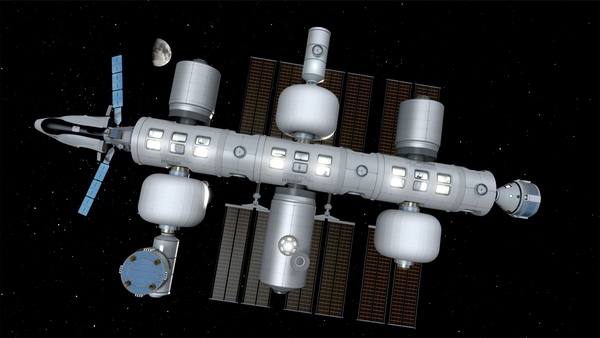 Blue Origin says it is “fully committed” to the Orbital Reef space station in cooperation with Sierra Space amid reports its interest in the project and/or partnership is fading. (credit: Blue Origin) |
Business and budget uncertainties
The competition for commercial space stations goes beyond the companies with NASA CLD awards and Axiom Space, which has a separate agreement with NASA allowing it to attach commercial modules to the ISS as a precursor to a commercial station. Several other companies that are also interested in commercial stations won CCSC-2 agreements in June, such as Think Orbital and Vast, as well as SpaceX, which is examining whether its Starship vehicles could be converted into stations. Still others, like Above:Orbital, Gravitics, and Space Villages, submitted proposals for CCSC-2 awards but were not selected by NASA.
| “The panel, being watchful of this extremely tight schedule, remains concerned that there is not yet a clear, robust business case for commercial LEO nor clear evidence of the financial viability” of the proposed stations, West said. |
Vast, for example, plans to use its CCSC-2 award to better understand NASA’s needs ahead of the next phase of the CLD program. It is working on a single-module commercial station called Haven-1 intended to support short-duration visits while it works on larger stations it will offer to NASA and others (see “A vastly different approach to space stations”, The Space Review, May 15, 2023). “It is our proof point that we can build an actual commercial space station, we can have a crew visit it,” Max Haot, CEO of Vast, said on the ASCEND panel. The company is working on a “CLD-compliant” station concept he said Vast would announce soon.
The number of companies pursuing commercial space stations, either with or without NASA support, is far greater than even the most optimistic projections of demand for them in the foreseeable future. That’s particularly true when many are betting on a post-ISS NASA to be the major customer for their stations.
“NASA would be the anchor tenant,” said Randy Lillard, Orbital Reef program manager at Blue Origin, on the ASCEND panel. “Their requirements define the initial space station and how it’s going to work. People are going to come once NASA starts flying.”
Uncertainty about commercial space station business plans has made its way to NASA’s Aerospace Safety Advisory Panel (ASAP). At its public meeting last week, members said they were concerned about the schedule and viability of those stations, which are critical in NASA’s plans to maintain a presence in LEO after the ISS.
“NASA should develop a comprehensive understanding of the resources and timelines of the ISS-to-commercial-LEO transition plan to a much higher level of fidelity, to provide confidence that the nation will be able to sustain a continuous human presence in LEO,” ASAP member David West said at the meeting, a recommendation backed by the full panel.
He noted NASA already has a “very tight” schedule in the CLD program to get at least one commercial station flying by the end of the decade. He suggested ASAP members were not yet convinced any of them had a business case that closed.
“The panel, being watchful of this extremely tight schedule, remains concerned that there is not yet a clear, robust business case for commercial LEO nor clear evidence of the financial viability” of the proposed stations, he said, “creating programmatic and safety risks with the entire plan for NASA LEO.”
The plan that ASAP recommends NASA develop, West said, “should be grounded in explicit defensible assumptions and should include quantifiable metrics and progress deadlines for ensuring that the market for commercial LEO activities exists and is sufficient to support the development, production, and operation of one or more commercial platforms to replace the ISS.”
Commercial space station developers, at least those working with NASA, are dealing with an additional degree of uncertainty. NASA requested $228.4 million for the CLD program in fiscal year 2024, projecting that to grow to more than $435 million in 2028. But that budget proposal predated a deal between Congress and the White House that caps non-defense discretionary spending—including NASA—at 2023 levels in 2024 with just a 1% increase in 2025.
| “The day will inevitably come when the station is at its end of life and we may not be able to dictate that date,” Sanders said about the deorbit vehicle. “This needs to be resourced, and resourced now, if we are to avert a catastrophe.” |
NASA officials have stated that they expect to get no more than 2023 funding levels in 2024, but the impacts on specific programs remains to be determined. Some in industry are privately worried that CLD will see its budget cut compared to those projections, further jeopardizing plans to have a station ready by the end of the decade.
“NASA has a very full mission plate. To the extent that their budget request is not fully funded, the leadership will need to make critical decisions,” said Patricia Sanders, chair of ASAP, at her committee’s meeting last week. “Either program content or schedules will need to be adjusted to meet fiscal realities.”
One NASA project that should proceed despite those fiscal realities, the panel said, was not CLD but instead the US Deorbit Vehicle (USDV), a spacecraft that would dock to the ISS and handle the final phases of its deorbiting into the South Pacific. NASA is seeking $180 million for USDV in 2024 and expects the project’s overall cost to approach $1 billion.
“The panel feels strongly and will continue to emphasize that funding the deorbit vehicle is not optional and it cannot be delayed,” West said. “It must be adequately funded in a timely fashion to provide the means for safely disposing of the ISS.”
“The day will inevitably come when the station is at its end of life and we may not be able to dictate that date,” Sanders added about the deorbit vehicle. “This needs to be resourced, and resourced now, if we are to avert a catastrophe.”
NASA may be preparing for a scenario where the deorbit vehicle is funded on schedule while commercial space stations suffer delays because of budget cuts or other problems. The request for proposals for USDV, released in September, is for a base contract for the USDV that runs through March 2031. However, the contract will include options that would stretch out the operations of USDV through as late as September 2035—just in case, it appears, if the commercial space station industry gets a little too chaotic.
Jeff Foust (jeff@thespacereview.com) is the editor and publisher of The Space Review, and a senior staff writer with SpaceNews. He also operates the Spacetoday.net web site. Views and opinions expressed in this article are those of the author alone.
Cosmos Calling
DISCOVERIES
The Cosmos Calling
Astronomers spotted a distant and powerful radio wave burst which took eight billion years to journey across the universe to reach Earth, CNN reported.
In their paper, scientists explained these signals are known as fast radio bursts (FRBs), which they describe as intense blasts of radio waves that last only a few milliseconds.
The recent burst, named FRB 20220610A, was identified using the Australian Square Kilometre Array Pathfinder radio telescope in Western Australia. The researchers explained that this FBR was peculiar because of its incredible energy release – in less than a millisecond, it emitted the same amount of energy as our Sun produces in 30 years.
While the origins of FRBs have puzzled scientists for years, the recent finding could help understand the sources of these cosmic signals.
Current theories suggest that these radio bursts may be linked to magnetars, highly energetic objects that result from the explosive deaths of massive stars.
The team explained that they traced FRB 20220610A to what appears to be a group of galaxies that are in the process of merging, interacting and forming new stars.
Still, studying these phenomena could also help in calculating the amount of matter between galaxies that remains unaccounted for in the universe.
“If we count up the amount of normal matter in the Universe – the atoms that we are all made of – we find that more than half of what should be there today is missing,” said study co-author Ryan Shannon.
Monday, October 30, 2023
Sunday, October 29, 2023
Saturday, October 28, 2023
Thursday, October 26, 2023
Wednesday, October 25, 2023
Tuesday, October 24, 2023
The Launch Industry Strains Launch Licensing
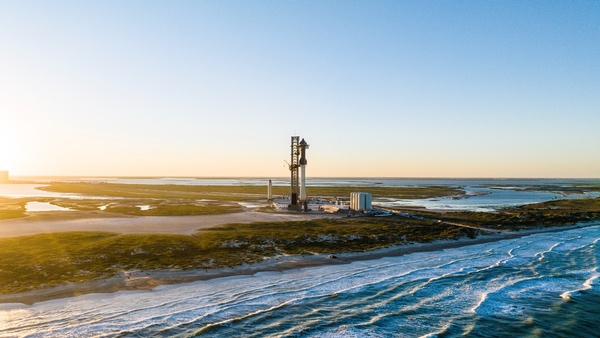 SpaceX is continuing pad tests of its second integrated Starship/Super Heavy vehicle as it awaits an updated FAA launch license. (credit: SpaceX) |
The launch industry strains launch licensing
by Jeff Foust
Monday, October 23, 2023
There is always some degree of tension between companies and regulators in almost any industry. That tension can be healthy as both companies and government agencies seek the right balance between ensuring safety and allowing progress.
There are signs, though, of strains between the launch industry in the United States and its main federal regulator, the FAA’s Office of Commercial Space Transportation, or AST. Changes in launch regulations intended to streamline the process may have done the opposite, slowing down licenses as companies seek to expand their launch activities.
| “Starship has been ready for its next flight test for more than a month, but we are waiting for an FAA license and accompanying interagency review,” said Gerstenmaier. |
At the forefront of those tensions is SpaceX. The company is preparing its Starship vehicle for a second test flight but needs an updated launch license from the FAA to do so. That requires the company to demonstrate to the FAA it has enacted recommendations from a mishap investigation into the first launch in April related to public safety.
The company, in social media posts, has indicated it is ready to go and is waiting on the FAA. “Starship team preparing for additional preflight tests in advance of a full launch rehearsal while continuing to work with the FAA on the Flight 2 license,” the company said on Friday, along with a photo of the full Starship/Super Heavy stack on the pad at its Starbase facility in Texas.
At a hearing last week by the Senate Commerce Committee’s space subcommittee, one SpaceX executive made those frustrations clear. “Starship has been ready for its next flight test for more than a month, but we are waiting for an FAA license and accompanying interagency review,” said Bill Gerstenmaier, vice president for build and flight reliability at SpaceX and a former NASA official who led the agency’s human spaceflight efforts.
He suggested the FAA was perhaps being too zealous in its oversight efforts, hindering SpaceX’s ability to test and iterate rapidly. “AST’s role is to protect public safety, not to ensure success of rocket launches,” he said. “Safe failure and rapid learning are often the fastest path to successful development.”
That had implications, he noted, not just for SpaceX but also for NASA, as a version of Starship will be used as the lunar lander for Artemis 3. In June, Jim Free, NASA’s associate administrator for exploration systems development, told two National Academies committees that the pace of Starship development “gives me concern” about the current official December 2025 date for that mission. “With the difficulties that SpaceX has had, I think that’s really concerning.”
“It’s important that we go fly as soon as we can,” Gerstenmaier said at last week’s hearing. “The hardware is really ready to go fly. When we have regulatory delays, such as we’re facing right now, that slows down developmental test flights and ultimately slows down our support to NASA, slows down our support for what we need to do to return humans back to the surface of the Moon again.”
“A continuous delay in each and every test flight adds up and, eventually, we will lose our lead and we will see China land on the Moon before we do,” he warned.
Gerstenmaier said after the hearing that the company was trying to make the best use of the licensing delay by conducting tests on the pad, including plans for a wet dress rehearsal where the rocket is filled with propellants and goes through a practice countdown. “We get the wet dress for free when we load for launch, but if we’re not going to get the launch license, it’s to our advantage to load now and reduce that risk,” he said.
There are also many other tweaks to the vehicle engineers can perform, but he noted they’re limited by the fact that they have an “unknown timeframe” for getting an updated license. “When we don’t know what the timeframe is, we don’t know how much work to do.”
He said SpaceX has tried to “lean forward” in its preparations for a potential launch, such as issuing maritime notices about potential launches that inevitable excite SpaceX enthusiasts; those notices, he said, require two weeks of advance notice. “I can’t stay in limbo forever.”
The FAA was not among the witnesses at the hearing. In an interview last month, Kelvin Coleman, FAA associate administrator for commercial space transportation, said his agency and SpaceX were making good progress on working through the 27 public safety recommendations from the mishap report that SpaceX must demonstrate they’ve implemented before the FAA will update the Starship launch license.
“We’re on a pretty good schedule,” he said then. “It’ll probably set us somewhere in mid to late October for conclusion of the safety review.”
| “Recent changes to the FAA regulations have not resulted in streamlined licensing reviews,” Schenewerk said. “Instead, Part 450 has proven more cumbersome and costly.” |
A complicating factor in that effort, though, is a separate review by the US Fish and Wildlife Service (FWS) about the environmental effects of the new water deluge system SpaceX has installed on the pad. That is designed to prevent the serious pad damage seen in the first launch, but FWS has to examine what impacts that system might have on the environment.
An FWS spokesperson said in September that once is receives the FAA’s “final biological assessment” it has up to 135 days to review it. The FAA delivered that assessment in early October, which means that FWS could take until early next year to complete its review.
“That piece is a little bit of a wild card,” Coleman said, but was optimistic it would not take nearly that long. “We’re hoping that piece will wrap up somewhere in proximity to the safety review.”
450 concerns
SpaceX is not the only company facing challenges with regulations. Other companies have run into problems with a new “streamlined” launch licensing regulation called Part 450, which took effect in 2021. The regulations were a response to calls by industry, with the backing of the Trump Administration through Space Policy Directive 2, to make it easier to demonstrate meeting safety requirements through performance-based standards rather than more prescriptive protocols.
That has not worked out in practice, at least so far. Caryn Schenewerk, president of CS Consulting and a former executive with SpaceX and Relativity Space, noted that only four Part 450 launch licenses have been issued to date, and at least two of them exceeded the 180-day review period by the FAA established in law.
“Recent changes to the FAA regulations have not resulted in streamlined licensing reviews,” she concluded. “Instead, Part 450 has proven more cumbersome and costly.”
“While well-intentioned, the Part 450 effort has not succeeded in accomplishing a streamlined process,” Gerstenmaier noted in his prepared testimony. “AST’s ability to process licenses in a timely fashion has declined rather than improved—indeed, as evidenced by licensing for the handful of applicants under Part 450, approval timelines are not improving.”
Wayne Monteith, former FAA associate administrator for commercial space transportation, said in his testimony that the rush to develop the Part 450 regulations may have contributed to the problems implementing them. “Based on the short development timeline, industry involvement in the regulatory process was severely limited,” he wrote. “Because of this compressed schedule some constructs within Part 450 were not as thoroughly vetted as would have been ideal.”
That’s further complicated by an increase in launch activity that is straining AST’s workforce. “Difficulties in implementing Part 450 regulations only exacerbate this workload,” said Phil Joyce, senior vice president for the New Shepard business unit at Blue Origin.
The problems with Part 450 extend beyond launch to reentries, which are also covered by the regulations. Varda Space Industries has been working with the FAA for months to get a license to return a capsule on its first satellite, launched in June to test technologies for pharmaceutical production in microgravity. That license, the first Part 450 reentry license, has not yet been issued.
Delian Asparouhov, co-founder of Varda, said in an interview last week he could not say if the company would have already gotten a license under the old regulations. The company also has to work with the Utah Test and Training Range to identify when that Air Force-run range can support a capsule landing.
“I feel confident that if there had been 10 previous Part 450 reentry operations, it would have gone much more smoothly,” he said of the licensing process.
Witnesses were unified in their call for additional resources for AST to allow them to hire more staff. Gerstenmaier argued for doubling the budget of AST, currently less than $38 million a year, provided the additional resources go into handling licensing.
| “I think the relationship is working pretty well,” the FAA’s Coleman said, “but there’s some challenges, of course that we have to work through from time to time.” |
He warned of dire consequences if regulations aren’t approved and more resources allocated to AST. “But, as AST transitions licenses for vehicles previously approved under legacy regulations to Part 450 over the next two years, the entire regulatory system is at risk of collapse,” he wrote in his prepared testimony. “AST’s workload over the next 12-24 months could result in the grounding of U.S. space launch capability if action is not taken immediately.”
Any increase in AST’s budget would be welcome news to Coleman. “The first thing we focus on—and we have a big focus on this during the course of the past year—is really trying to make sure that we have the requisite staff on hand, hiring and bringing the talent pool in that we need in commercial space to keep pace with industry,” he said.
He attributed the issues industry had with Part 450 to “growing pains” of new regulations. “It’s not only challenges on the government side but on the industry side as well,” he said. The transition to Part 450 will last until 2026, when all existing licenses under old regulations have to convert to Part 450 licenses.
“As we get more experienced and as more companies get more experienced, I expect us to really see the full benefits of Part 450 come to the forefront and see some nice gains from that,” he said.
That tension, though, about regulations and the speed of licensing will continue for some time. SpaceX CEO Elon Musk has publicly complained about the slow pace of licensing at the FAA in posts on the social media network X (formerly Twitter) that he acquired last year.
Coleman, though, noted in an interview last month, after those comments, the Musk visited FAA headquarters to discuss Starship licensing, meeting with him and FAA leadership. It was “a good conversation,” he said. “I think the relationship is working pretty well, but there’s some challenges, of course that we have to work through from time to time.”
Even Musk said as much. “In fairness to the FAA, it is rare for them to cause significant delays in launch,” he posted last month. “Overwhelmingly, the responsibility is ours.”
Jeff Foust (jeff@thespacereview.com) is the editor and publisher of The Space Review, and a senior staff writer with SpaceNews. He also operates the Spacetoday.net web site. Views and opinions expressed in this article are those of the author alone.
India Prepares For Human Spaceflight
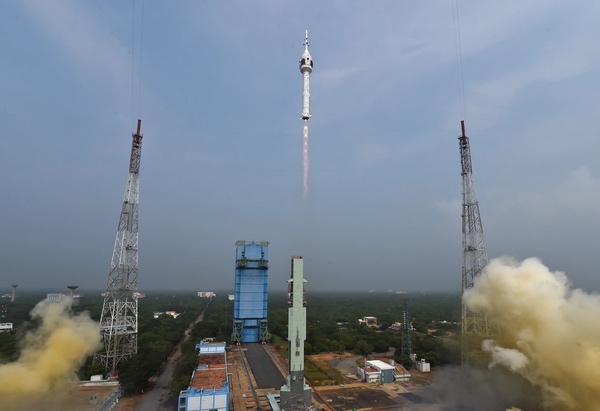 Liftoff of the TV-D1 mission October 21 to demonstrate the crew escape system for the Gaganyaan spacecraft. (credit: ISRO) |
ISRO prepares for human spaceflight
by Gurbir Singh
Monday, October 23, 2023
In 2025, India is planning its first crewed spaceflight, carrying astronauts on an Indian launch vehicle, launched from India. On October 21, ISRO conducted an uncrewed in-flight abort test. One minute into the flight, the Crew Escape System fired for just over two seconds, pulling the crew module away from the launch vehicle. The momentum took the crew module to an altitude of 17 kilometers, where the Crew Escape System itself separated from the crew module. Neither the launch vehicle nor the Crew Escape System were recovered. The crew module descended to a safe splashdown ten kilometers downrange, first using a pair of drogue parachutes and then three main parachutes. About nine minutes after launch the mission concluded having met all the mission objectives successfully.
| Since Yuri Gagarin’s first human spaceflight in 1961, launch escape systems have been activated in three instances and saved the lives of the crew in each case. |
ISRO concluded this in-flight abort test a complete success despite the poor weather that obscured the launch and the descent. Infrared cameras and the telemetry provided ISRO with the data it required. The ISRO chairman explained that the unexpected hold at T-5 seconds during the first launch attempt was due to the automatic launch sequence detecting a weather threshold breach. The rescheduled launch attempt 45 minutes later was successfully completed despite the crew capsule initially floating upside down. This is not an unexpected outcome for NASA, as the Apollo 11 crew capsule was discovered just after splashdown in July 1969. NASA referred to this position as “Stable 2”.
In emergencies, ships have lifeboats and aircraft have inflatable evacuation slides. Most crewed launch vehicles heading for space have launch abort or escape systems. They can be activated on the launchpad before launch or soon after launch. Like an ejection seat used by a fighter pilot in an emergency, small but fast-acting solid motors separate the crew module from the rest of the launch vehicle for a safe evacuation. Since Yuri Gagarin’s first human spaceflight in 1961, launch escape systems have been activated in three instances and saved the lives of the crew in each case.
In April 1984, Rakesh Sharma, India's first astronaut, spent a week on board Salyut 7 as part of the USSR's Interkosmos program. Six months earlier, on September 26, 1983, flight engineer Gennady Strekalov and his commander Vladimir Titov survived the fire that broke out moments before the launch of Soyuz T-10-1. The crew escape system fired, separating the crew module from the inferno that engulfed the launch vehicle seconds later. The crew module landed safely four kilometers away. The commander and engineer were bruised and shaken but fully recovered, aided by cigarettes and vodka.
Both Rakesh Sharma and Ravish Malhotra watched this drama unfold in real time, as the next Soyuz flight would be theirs. On April 2, 1984, Gennady Strekalov and Rakesh Sharma were part of the crew launched on the successful Soyuz T-11 mission to Salyut 7. Sharma and Malhotra had been in training in Star City since September 1982. Both were Indian Air Force test pilots and familiar with high-risk missions. Sharma recalled he did not tell his wife about witnessing this launch failure “as had been my practice right through my flying and testing career.”
Soyuz-T-10 was the second use of a launch abort system, the first took place during the Soyuz 7K-T No.39 mission almost a decade earlier. It was taking a crew of two to the Salyut 4 space station on April 5, 1975. About five minutes after launch, separation between stage two and stage three did not go as planned, compromising the mission. The Soyuz activated the escape system separating the crew module from the launch vehicle. Twenty minutes after launch the crew landed safely in the USSR on a snow-covered hillside close to the Chinese border. Thinking they may have landed in China, the crew destroyed sensitive documents associated with the military experiments they intended to conduct in orbit. Thanks to their survival suits and training, they endured the freezing temperature overnight and were recovered on the following day.
The third incident took place on October 11, 2018, when Soyuz MS-10 experienced a booster separation issue a few minutes after launch. This meant NASA astronaut Nick Hague and Russian cosmonaut Aleksey Ovchinin would not reach their destination, the International Space Station. The Soyuz initiated the abort, separating the crew module from the launch vehicle and landed safely about 20 minutes after launch. Despite experiencing a force of around 7 g’s, both crew members were safely recovered in good health and returned to Baikonur. Soyuz MS-12 launched in March 2019 and successfully completed the mission objectives originally planned for the MS-10 mission.
| It may well be that the next Indian astronaut to fly in space will be on the ISS, before Gaganyaan. |
Developing and testing Gaganyaan’s Crew Escape System is one of the many prerequisite critical systems ISRO must develop and demonstrate prior to the first crewed flight. India's human spaceflight program has had a checkered history. The first public report of India's intention to develop a human spaceflight program came in 2007. The program was formalized and announced in 2009 but not really funded. At that time, the close relationship between ISRO and Roscosmos was expected to deliver results by 2016. That timeline did not materialize but ISRO has been quietly developing many of the critical systems required for the Gaganyaan program since. The formal political announcement came from the prime minister on India’s independence day, August 12, 2018. The goal then was the first crewed flight in 2022 to mark India’s 75th year of independence. Many delays, including from Covid, have shifted the first launch to at least 2025. In the meantime, ISRO has been developing critical technologies including environmental control systems, prototypes of spacesuits, and human-rating the LVM3. It has also conducted a drop test of the crew module from a helicopter and the recovery procedure after splashdown.
On July 5, 2018, ISRO conducted a pad abort test. Whilst stationary at the launch pad, the crew module was pulled away to an altitude of about three kilometers and safely splashed down less than five minutes later in the Bay of Bengal. ISRO has also conducted two flights that have involved recovering a spacecraft ISRO has launched. During a short 20-minute suborbital flight on December 18, 2014, ISRO conducted the Crew Module Atmospheric Re-entry Experiment (LVM3-X/CARE). This was an experimental suborbital flight powered only by the first and second stages of an LVM3. In January 2007, ISRO launched the Space Recovery Experiment. After 12 days in orbit, the SRE-1 was commanded to reenter allowing ISRO to test procedures for de-orbit, navigation, guidance, thermal protection, parachutes, and recovery from a predesignated point in the Indian Ocean. That 2007 recovered module is now in an ISRO museum.
ISRO tends to avoid launches in October when the monsoon season is still active. The poor visibility, the unexpected hold during the first launch attempt, the recovery of the capsule by the Indian Navy from an initial “stable 2” position all made a positive contribution to this rehearsal towards an actual crewed mission. In June 2023, India signed NASA’s Artemis Accords. It included a potential flight of an Indian astronaut to the ISS in 2024. It is unlikely but, if that happens, the astronaut selected will be one of four Indian Air Force test pilots already trained in Star City in preparation for the Gaganyaan mission. So, it may well be that the next Indian astronaut to fly in space will be on the ISS, before Gaganyaan.
Gurbir Singh is the author of The Indian Space Programme.
A Pioneer In Space Satellite Photography Leaves Us At Age 86
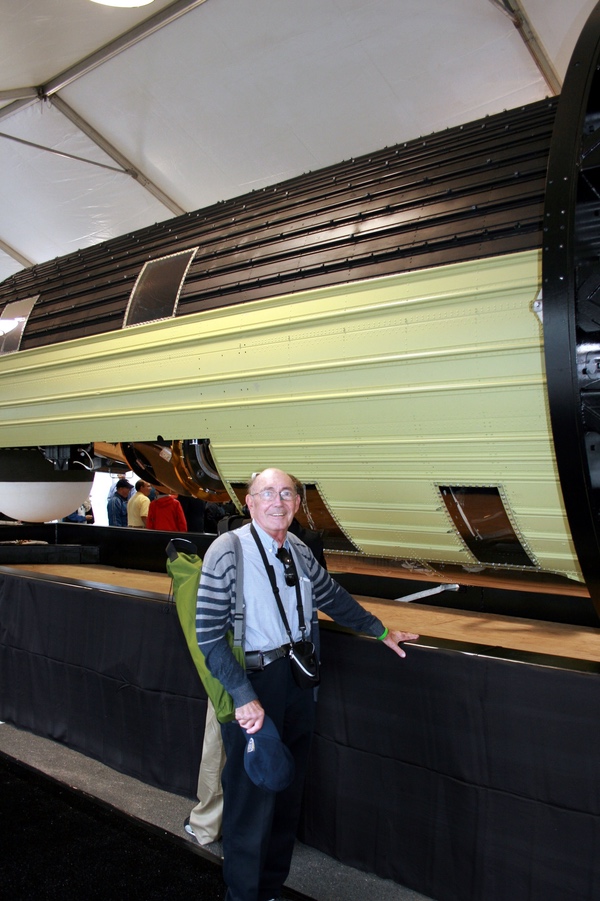 Phil Pressel, one of the designers of the HEXAGON reconnaissance camera, standing next to the engineering mockup of the satellite in 2011. (credit: Roger Guillemette) |
Phil Pressel
Monday, October 23, 2023
Philip Pressel passed away on October 18 at the age of 86. Phil was among the designers of the reconnaissance cameras carried aboard the HEXAGON reconnaissance satellite from 1971 to 1986. In addition, he worked on other national security programs during his long career at Perkin-Elmer Corporation. He was an immigrant and Holocaust survivor.
| While at Perkin-Elmer in the mid-1960s, he was assigned to design the sophisticated camera system for the HEXAGON, which was tasked with photographing vast areas below the satellite as it traveled in a polar orbit, providing intelligence on the Soviet Union during the Cold War. |
Phil was born in Antwerp, Belgium, to Miriam and Joseph Pressel. Phil and his parents fled to France when Hitler invaded Belgium. They were in hiding until the end of the war. At one point Phil was sheltered for a time in Vourles, France, by the Sabathiers, a kind Catholic family. Phil remembered that under the cover of night men in the town would head down out of the mountains to sabotage German equipment and facilities, returning before dawn. His years in hiding from the Nazis affected him for the rest of his life.
After the war, the family immigrated to New York as his dad was hired by the United Nations as a translator. Joseph Pressel died at age 51. His mother supported the family as a seamstress and died at 104. Phil attended Stuyvesant High School, NYU, and the University of Pennsylvania. He became a mechanical engineer and, while at Perkin-Elmer in the mid-1960s, he was assigned to design the sophisticated camera system for the HEXAGON, which was tasked with photographing vast areas below the satellite as it traveled in a polar orbit, providing intelligence on the Soviet Union during the Cold War.
After his initial work on the HEXAGON camera system (which continued for nearly two decades), Phil worked on other national security programs. One of them involved designing a large missile-tracking telescope system known as “Lazy Cat” that was installed on a mountaintop in Iran and used to track Soviet missiles and rockets in flight.
Phil wrote two books: They are Still Alive, a biography; and Meeting the Challenge, a book about the HEXAGON satellite. He often spoke to groups about the Holocaust, HEXAGON, and designing instruments for space. He loved officiating track and field meets, traveling, and swimming. An organ transplant recipient, he often participated in the Transplant Games, a “celebration of life” centered on the donors and recipients of organ transplants.
I first met Phil around 2004 when one evening I received a phone call from him. He asked me if I “wrote that article about why that thing is not in the Smithsonian.” I told him I had, and he replied “I helped build that thing.” He would not say the word “HEXAGON,” which was still classified, nor even confirm that it was a satellite with a camera. He asked if I knew when the program was likely to be declassified. I told him that it would probably not happen until the 50th anniversary of the National Reconnaissance Office in 2011. He was disappointed to hear that, and mentioned that he was working on a book on his work on the program. I offered some suggestions that he try to avoid writing a dry book about engineering and try to describe the work environment, the people, and the difficulties of operating in a highly classified environment. He took my advice to heart, and when, the program was declassified in September 2011 and his book was reviewed for security purposes, he asked if I would be willing to look at the manuscript for him. I did so and was surprised that he had written an engaging and insightful book. I primarily recommended that he cut it down by about a third, and make a slight change to the title. The book was later edited and published by AIAA Press.
Phil had four children: Allan, David, and Linda; and six grandchildren: Robert, Adam, Austin, Julia, Zachary, and Elliott. He was predeceased by his son, Stephen. The “love of his life” was his wife, Pat, who lives in Massachusetts.
Dwayne Day can be reached at zirconic1@cox.net.
Space Pioneer Alan Stern Prepares For His Suborbital Space Flight
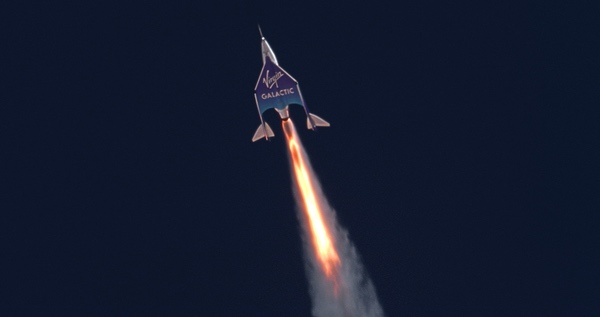 Virgin Galactic’s SpaceShipTwo on ascent to space. (credit: Virgin Galactic) |
My suborbital life, part 1: Childhood’s end, perseverance pays
by Alan Stern
Monday, October 23, 2023
Late next week, I’m scheduled to launch aboard Virgin Galactic’s VSS Unity on a suborbital spaceflight. I’m not flying as a private astronaut, though, as most Virgin Galactic customers are, but as a researcher, headed to work in space.
During the flight, I will be conducting training and experiment risk-reduction activities in preparation for a second suborbital flight that NASA selected me to fly with astronomical and physiological performance experiments. This first flight, also known as Galactic 05 or G05 (for Virgin Galactic’s fifth commercial flight), is funded entirely by my employer, the Southwest Research Institute, under an Internal Research and Development grant.
| More than 55 years after my boyhood dream first materialized, I will actually fly in space next month. |
To be honest, I have wanted to fly aboard space missions since I was a kid growing up in awe of the Apollo program. As a young engineer, and then as a young scientist, I did everything I could think of to make myself a top candidate to be a NASA astronaut. I learned scuba diving, I did a stint at the South Pole, I took degrees in five separate technical fields (including three graduate degrees) and made exceptional grades. I also learned to skydive and to fly, became a commercial pilot and a flight instructor, and even earned a sailplane rating. I was principal investigator on experiments on shuttle missions, flew dozens of high-altitude astronomy missions on high-performance NASA F-18s and WB-57 aircraft, and personally did the real-time telescope steering of seven suborbital science rocket missions, all without a single mistake. I even became and worked as a state certified Emergency Medical Technician (EMT).
Eventually, after six applications to be a NASA Space Shuttle mission specialist, I was invited to Houston for interviews, but I fell short and was not selected. It was heartbreaking. I was later approved by NASA Johnson Space Center’s astronaut office to fly as a shuttle payload specialist on a time-critical flight to study comet Hale-Bopp, but was later bumped from the flight for a Canadian Space Agency mission specialist, owing to international politics trumping time-critical science.
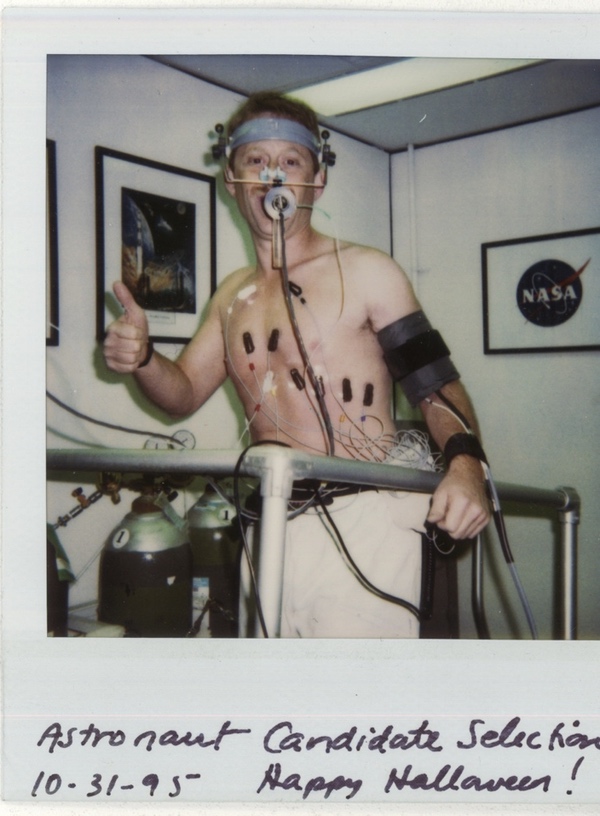 Undergoing NASA astronaut physicals, Halloween, 1995. (credit: NASA) |
Now, more than 55 years after my boyhood dream first materialized, I will actually fly in space next month. And best of all from my perspective, I will go there to work, rather than just settle for a tourist seat.
It’s hard for me to process how long I have held this dream and how much effort, most of it unsuccessful (or at best preparatory), that I’ve invested to realize it. And now it’s truly surreal to write that I am flying on the very next human spaceflight mission.
Thinking back to my boyhood in the 1960s and 1970s, I imagined that my generation would fly to space routinely, that many of us would be the second-generation explorers of the Moon, and that a few of us would even be the first-generation explorers of Mars. For my generation, that future was never realized.
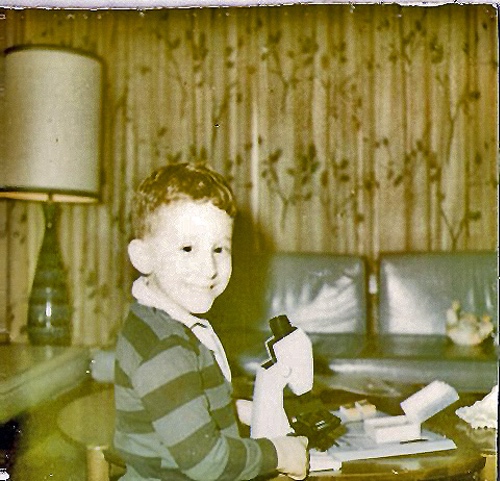 My boyhood self with my first scientific instrument. (credit: Stern family) |
But the future we actually live in, thanks to the rise of commercial spaceflight, is reaching a turning point that I expect will be viewed in later centuries as the pivotal inflection point in human history when we homo sapiens really did become spacefaring on a grand scale, leading soon to our species being explorers of our entire solar system.
It’s now just days until my scheduled spaceflight.
Every night, as I watch the Moon progress through its phases, I visualize it as a countdown clock leading to the waning gibbous phase it will reach on our flight day early next month.
Strangely, at an age that my grandparents were riddled with disease and in decline, I am going to space as a rookie researcher, accelerating at up to 3.5 Gs up that hill to apogee more than 50 miles above the Earth, and at speeds up to Mach 3 to conduct space training and experiment activities.
Perseverance pays. And I just can’t wait.
Alan Stern is a planetary scientist and aerospace executive. He is a former NASA Associate Administrator for Science, and a former board chair of the Commercial Spaceflight Federation. He has now been a part of 30 NASA, ESA, and commercial spaceflight flight mission teams, 15 of those as mission or instrument Principal Investigator, including the almost $1 billion New Horizons mission to Pluto and the Kuiper Belt.